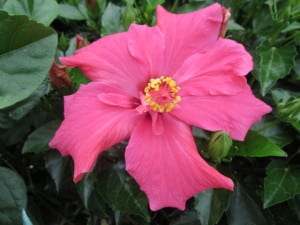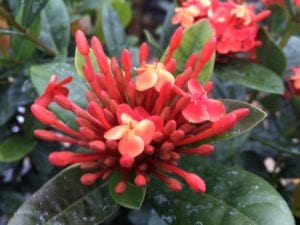When visiting the tropics, it’s not just the white, glistening sand and the crystal-blue waters that draws us in. The tropics are full of gorgeous flora full of vibrant, bold, bloom colors and deep, jungle-green foliage. When surrounded by these tropical plants, we tend to take in their beauty and allow ourselves to slow down, relax and take a moment to breathe a little easier. Tropical plants just exude tranquility. Who doesn’t need more tranquility in their lives. I think we’ll be hard-pressed to find anyone who can claim that.
Today is all about highlighting some of our favorite plants that give off that highly sought after tropical vibe and also do well in our San Antonio climate.
4 Tropical Vibe Plants for San Antonio
Tropical Hibiscus: There are few summer-flowering shrubs that are able to rival the bountiful, bold, colors of the blooms on tropical hibiscus. The flowers on tropical hibiscus are numerous, and while they only last for a day, each new day you are greeted with a fresh bloom. These plants will need winter protection when temperatures are predicted to fall below 45°F. A simple, secure drape of frost cloth will suffice, or if planted in a pot, simply bring inside for cold protection.
Routine care of tropical hibiscus includes offering full sun, well-draining soil rich in organic matter and nutrients, keeping soil moist but not soggy, and feeding with a product like Nelson Plant Food Hibiscus and Flowering Tropicals granular fertilizer.


Tropical Hibiscus


Shrimp Plant
Shrimp Plant: The subtropical/perennial shrimp plant can easily create a tropical feel in your landscape. Growing 3′ tall x 3′ wide, the shrimp plant boasts big, beautiful, rosy-red bracts that draw in hummingbirds and contrast nicely with deep-green foliage. Shrimp plants are cold hardy to about 25°F. Plant in soil rich in organic matter, and keep soil moist but not soggy.
With their upright growth habit, shrimp plants look great as both potted specimens, and in the landscape. Although shrimp plants generally like sunshine, you should offer them a little reprieve from the the hottest rays during the summer. A spot that gets full morning sun and some afternoon shade or filtered shade. (We also love the Lollipop plant which is similar in care and appearance as the shrimp plant, but it produces lemon-yellow bracts)
Ixora: Ixora is another of our favorites. One look at the huge clusters of flowers on this tropical perennial plant and you’ll know why it is also called the ‘Jungle Geranium’. Full sun and well-draining, slightly acidic soil is best for growing these subtropical plants. If soil becomes too alkaline, the leaves will become slightly chlorotic (yellowed). You can remedy this by amending soil with peat moss, pine bark, and offering acidic fertilizer.
Ixora likes moist (not soggy) soils, full sun, and a little pruning and fertilizing in spring. Other than that, ixora is a relatively low maintenance plant. Ixora grows about 4′-6′ tall and about 4′ wide. Freeze will damage the plant, or possibly kill it, so plant in containers you can bring in over winter, or stock up on frost protection and make plans to cover it in temps from 32°-40°.


Ixora


Canna
Cannas: Cannas are tropical perennials that can quickly create an island vibe in your landscape. Large, lush, upright foliage, reminscent of banana tree leaves, comes in a variety of colors and patterns and is reason enough to love the plant. Add the large, bold blooms that beckon to hummingbirds and butterflies and cannas become a “have to have it ” type of plant. Bloom colors can be found in red, orange, pink, salmon, yellow, white, and even bicolor.
Cannas grow 4′-8′ tall x 4′- 6′ wide, depending on variety. It is recommended to divide canna rhizomes every 3-4 years, either in fall or early spring, as cannas can spread quickly. At least half a day of sun is best for these tropical perennials. While cannas are heat and drought tolerant once established, they are also fine if planted in wetter areas. Cannas will freeze down to the rhizomes in winter, but generally return each year.
Don’t let astronomical travel expenses get you down this summer. Stay home and bring the tropics to your landscape instead!
~The Happy Gardener, Lisa Mulroy


Do you have multi-color hibiscus plants? Also, orange color esperanza?
Our Bandera location has a good selection of multi-color hibiscus this weekend. Unfortunately our order of orange esperanza did not arrive.
does thousand oaks have tropical hibiscus or hibiscus seeds or get them this weekend or no
Hi Olav,
Thousand Oaks has a great selection of tropical hibiscus right now! Should be plenty available to choose from during your visit this weekend.